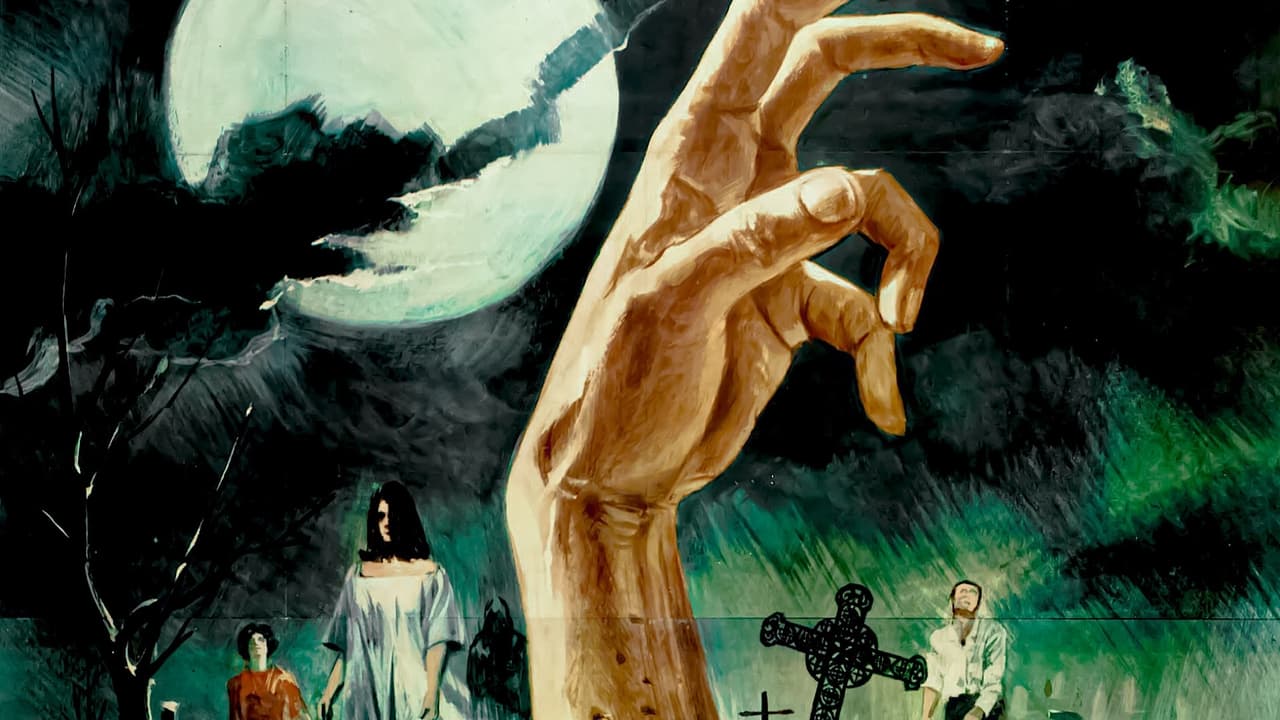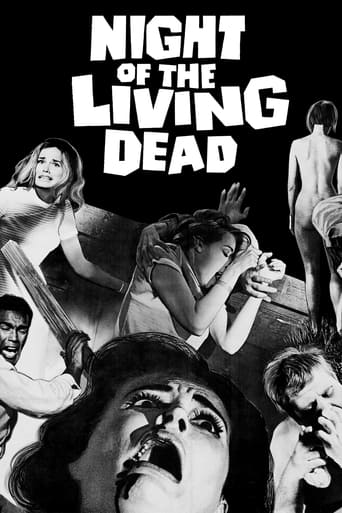

brilliant actors, brilliant editing
... View MoreAlthough it has its amusing moments, in eneral the plot does not convince.
... View MoreThere are moments that feel comical, some horrific, and some downright inspiring but the tonal shifts hardly matter as the end results come to a film that's perfect for this time.
... View MoreThis movie feels like it was made purely to piss off people who want good shows
... View MoreGeorge Romero's black & white cult low budget zombie film, Night of the Living Dead is now regarded as a seminal classic.It is not a great film. The acting is ropy, the zombie effects are not that good and it is too talky. However it did rewrite the rules for low budget horror films.Two siblings are visiting their father's grave and are attacked by a strange looking drifter. The woman, Barbara (Judith O'Dea) runs to an abandoned farmhouse to escape him.Ben (Duane Jones) a black man also escapes to the farmhouse where she meets Barbara who is in shock. Ben barricades both of them inside the farmhouse by reinforcing the doors and windows.They encounter several other people who have been hiding out in the cellar. They learn on the radio that radiation contamination from a space probe has somehow reactivated the brain of dead people. These people were now devouring the flesh of the living who themselves would come back as zombies.It is a classic base under siege scenario with various types of people bickering, arguing and reluctantly joining forces. The film is notable that the lead is played by a black actor who is ordering the other survivors around, even shouting at them. In retrospect that looks like a brave piece of casting.Jones does give the film's best performance. O'Dea is pretty bad though, the zombies are more animated than her.
... View MoreThe granddaddy of modern zombie films and arguably also the progenitor of the modern day horror film. NOTLD's story should be familiar to modern horror audiences, even if you've never seen this film before, as this film's influence on survival horror films cannot be emphasized enough. The recently dead mysteriously rise and come to life to mindlessly feed on the flesh of the living, who then in turn become the undead themselves to create more undead flesh eaters. The film follows a disparate group of survivors who have found shelter in an abandoned farmhouse where they barricade doors and windows, share information/stories about what they think is going on outside, bicker amounts themselves over what to do in the situation, and all of the usual tropes we typically see in horror siege films. Writer/producer/director George A. Romero gets credit with this film for creating the "rules" for zombies (i.e. zombies are slow and dumb, anyone who dies will rise to feast on the living, you must destroy the brain to kill a zombie, etc.), in much the same way Bram Stoker made established the rules for modern vampire depiction with Dracula in 1897 or how Curt Siodmak established the rules for werewolves with his script for "The Wolf Man" in 1941. Romero's zombie rules are taken for granted at this point, but it's a major achievement that may not be quite appreciated, to have essentially invented a movie monster that has continued to endure for over than 50 years. Romero's zombie rules have been followed by most zombie movies up until "28 Days Later" when filmmakers and authors started playing with the rules (much the same way that's been done with vampires and other creatures of the night), but Romero's rules have still been adhered to by everything from Max Brooks' "Zombie Survival Guide" to Robert Kirkman's "The Walking Dead." Without "Night of the Living Dead" we would never have had the many end-of-the-world classics like Lucio Fulci's "The Beyond," Sam Raimi's "Evil Dead," Stuart Gordon's "Re-Animator," Robert Kirkman's "The Walking Dead," Charlie Brooker's pre-Black Mirror TV mini-series "Dead Set" or the above mentioned "28 Days Later," not to mention a ton of great zombie fiction from authors like Stephen King, Joe R. Lansdale, and Brian Keene, or some great tongue-in-check zombie films like Grindhouse's "Planet Terror" or Simon Pegg's "Shaun of the Dead," or some fun lesser but entertaining zombie films like "REC," "Dead Snow," "Dead Alive," "Zombieland," "Le Horde," "Shock Waves," "Juan of the Dead," "The Dead," "Night of the Comet," "Demons," "Pontypool," "Return of the Living Dead," or the super gory "Zombie 2" (Wondering about Zombi 1? Romero's sequel to NOTLD "Dawn of the Dead" was released in Italy as "Zombi" and this Italian production was marketed as a sequel). Romero also gets credit with "Night of the Living Dead" for establishing the horror film siege scenario that's endlessly been used to this very day (everything from "Assault on Precinct 13" to "Aliens" to "From Dusk till Dawn" to "The Mist" to "30 Days of Night" to "The Purge"). Sure there were siege films going back as far as "The Lost Patrol" or "Rio Bravo," but Romero established the plot, story, and genre elements that remain strong to this dya. The cultural influence of this "Night of the Living Dead" cannot be emphasized enough. Looking at the film on it's own, Romero doesn't just tell a zombie siege film story, but also injects a smart political subtext into the film about race relations. Ben, a black man, and Mr. Cooper, a privileged white man, clash throughout the film as to if it's better solidly barricade themselves in the basement or to stay upstairs with the partially barricaded doors and windows to have a potential path for escape if needed. It's notable that Ben has the only gun in the film and Mr. Cooper desperately wants to literally wrench it from Ben's grasp to take control of the situation. For a film in the 1960s, it's quite provocative to cast a black man in in the heroic lead role, telling a group of white people what to do. Romero admitted that he didn't write the character of Ben as a black man, but that after casting the excellent Duane Jones, the story began to take on these elements of race and politics. SPOILER ALTER! At the end of the film, it's undeniable when Ben, the only surviving member of the group, is casually killed by a redneck posse and his corpse thrown on a bonfire, quickly followed by black & white newspaper photographs of the incident, that the audience would think of the recent assassinations of Martin Luther King Jr. and Malcom X. "Night of the Living Dead" also works as a Cold War parable for US involvement in Vietnam. The US has better technology and know how, but were overwhelmed by the sheer numbers and the relentlessness of those who they were fighting. So overall, although the acting is admittedly not the best (except for Jones) and the production values are pretty low, "Night of the Living Dead" is a classic that has greatly influenced innumerable books, movies, comics, TV show, and popular culture ever since and in ways than cannot be over stated.
... View MoreI should alert readers that I am not very knowledgeable about the modern zombie genre, so my review should be taken accordingly as one by an unenlightened old geezer who is not at all hip to the twenty first century.This classic horror movie's greatest strength is its carefully developed and successful "creepiness factor" by director George Romero. After many viewings, I am still terrified when the man walking among the cemetery monuments (Bill Heinzman) suddenly begins to attack Barbara (Judith O'Dea) before moving on to her brother, Johnny, (Russell Streiner), and then begins to chase her into an isolated farmhouse before being joined by what becomes an army of his fellow ghouls, mysteriously raised from the dead. Heinzman not only imitates Karloff very well, but he looks like him! It's my worst nightmare being brought to life on the screen.Although the music is stock material, it was well chosen for its fear effect and downright creepiness. Considering its low budget, Romero's ability to create such a spine-chilling movie is very impressive and commendable.One of the problems with the film, however, is that it fails to sustain the intensity of its opening scenes and loses its punch along the way. I understand that the dialogue was often spontaneous, but it was also often weak, as was much of the acting. This may be controversial, but I didn't get the racial theme that many IMDb reviewers mentioned. I saw Ben as Ben without regards to his race. Harry views both Ben and Tom, who is white, with contempt, and I didn't understand why Ben didn't shout out "Help! I'm not a zombie!" as soon as he heard gunshots outside. He had to know that the zombies were incapable of shooting weapons. Also, the scientists and military officials in Washington were not very credible. They were actually laughable, as was their dialogue.In spite of the weaknesses, this film remains as a remarkable, pioneering classic in the horror genre, and I will continue to watch it and fear it.
... View MoreI do feel bad for not enjoying this movie as much as a lot of people seem to. I think me being so spoiled by modern zombie movies and culture may have something to do with it. For it's time period, it was pretty well done and I definitely noticed how many things current movies have borrowed from it. That being said, I doubt I'll be watching it again. There are plenty of better zombie movies to spend my time on.
... View More